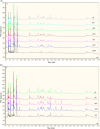Transcriptional and functional characterization of genetic elements involved in galacto-oligosaccharide utilization by Bifidobacterium breve UCC2003
- PMID: 23199239
- PMCID: PMC3815386
- DOI: 10.1111/1751-7915.12011
Transcriptional and functional characterization of genetic elements involved in galacto-oligosaccharide utilization by Bifidobacterium breve UCC2003
Abstract
Several prebiotics, such as inulin, fructo-oligosaccharides and galacto-oligosaccharides, are widely used commercially in foods and there is convincing evidence, in particular for galacto-oligosaccharides, that prebiotics can modulate the microbiota and promote bifidobacterial growth in the intestinal tract of infants and adults. In this study we describe the identification and functional characterization of the genetic loci responsible for the transport and metabolism of purified galacto-oligosaccharides (PGOS) by Bifidobacterium breve UCC2003. We further demonstrate that an extracellular endogalactanase specified by several B. breve strains, including B. breve UCC2003, is essential for partial degradation of PGOS components with a high degree of polymerization. These partially hydrolysed PGOS components are presumed to be transported into the bifidobacterial cell via various ABC transport systems and sugar permeases where they are further degraded to galactose and glucose monomers that feed into the bifid shunt. This work significantly advances our molecular understanding of bifidobacterial PGOS metabolism and its associated genetic machinery to utilize this prebiotic.
© 2012 The Authors. Published by Society for Applied Microbiology and Blackwell Publishing Ltd. This is an open access article under the terms of the Creative Commons Attribution License, which permits use, distribution and reproduction in any medium, provided the original work is properly cited.
Figures







Similar articles
-
Metabolism of a plant derived galactose-containing polysaccharide by Bifidobacterium breve UCC2003.Microb Biotechnol. 2011 May;4(3):403-16. doi: 10.1111/j.1751-7915.2010.00218.x. Epub 2010 Oct 21. Microb Biotechnol. 2011. PMID: 21375716 Free PMC article.
-
Metabolism of biosynthetic oligosaccharides by human-derived Bifidobacterium breve UCC2003 and Bifidobacterium longum NCIMB 8809.Int J Food Microbiol. 2020 Mar 2;316:108476. doi: 10.1016/j.ijfoodmicro.2019.108476. Epub 2019 Dec 9. Int J Food Microbiol. 2020. PMID: 31874325
-
Galacto- and Fructo-oligosaccharides Utilized for Growth by Cocultures of Bifidobacterial Species Characteristic of the Infant Gut.Appl Environ Microbiol. 2020 May 19;86(11):e00214-20. doi: 10.1128/AEM.00214-20. Print 2020 May 19. Appl Environ Microbiol. 2020. PMID: 32220841 Free PMC article.
-
Structure and evolution of the bifidobacterial carbohydrate metabolism proteins and enzymes.Biochem Soc Trans. 2021 Apr 30;49(2):563-578. doi: 10.1042/BST20200163. Biochem Soc Trans. 2021. PMID: 33666221 Free PMC article. Review.
-
A molecular basis for bifidobacterial enrichment in the infant gastrointestinal tract.Adv Nutr. 2012 May 1;3(3):415S-21S. doi: 10.3945/an.111.001586. Adv Nutr. 2012. PMID: 22585920 Free PMC article. Review.
Cited by
-
Prebiotics metabolism by gut-isolated probiotics.J Food Sci Technol. 2020 Aug;57(8):2786-2799. doi: 10.1007/s13197-020-04244-5. Epub 2020 Jan 20. J Food Sci Technol. 2020. PMID: 32624588 Free PMC article. Review.
-
Infant-Associated Bifidobacterial β-Galactosidases and Their Ability to Synthesize Galacto-Oligosaccharides.Front Microbiol. 2021 May 3;12:662959. doi: 10.3389/fmicb.2021.662959. eCollection 2021. Front Microbiol. 2021. PMID: 34012427 Free PMC article.
-
Synbiotic Effect of Bifidobacterium lactis CNCM I-3446 and Bovine Milk-Derived Oligosaccharides on Infant Gut Microbiota.Nutrients. 2020 Jul 29;12(8):2268. doi: 10.3390/nu12082268. Nutrients. 2020. PMID: 32751149 Free PMC article.
-
Metabolism of the predominant human milk oligosaccharide fucosyllactose by an infant gut commensal.Sci Rep. 2019 Oct 28;9(1):15427. doi: 10.1038/s41598-019-51901-7. Sci Rep. 2019. PMID: 31659215 Free PMC article.
-
Linking human milk oligosaccharide metabolism and early life gut microbiota: bifidobacteria and beyond.Microbiol Mol Biol Rev. 2024 Mar 27;88(1):e0009423. doi: 10.1128/mmbr.00094-23. Epub 2024 Jan 11. Microbiol Mol Biol Rev. 2024. PMID: 38206006 Free PMC article. Review.
References
-
- Alvarez-Martín P, O'Connell-Motherway M, van Sinderen D, Mayo B. Functional analysis of the pBC1 replicon from Bifidobacterium catenulatum L48. Appl Microbiol Biotechnol. 2007;76:1395–1402. - PubMed
-
- Coulier L, Timmermans J, Bas R, Van Den Dool R, Haaksman I, Klarenbeek B, et al. In-depth characterization of prebiotic galacto-oligosaccharides by a combination of analytical techniques. J Agric Food Chem. 2009;23:8488–8495. - PubMed
Publication types
MeSH terms
Substances
LinkOut - more resources
Full Text Sources
Other Literature Sources
Research Materials

